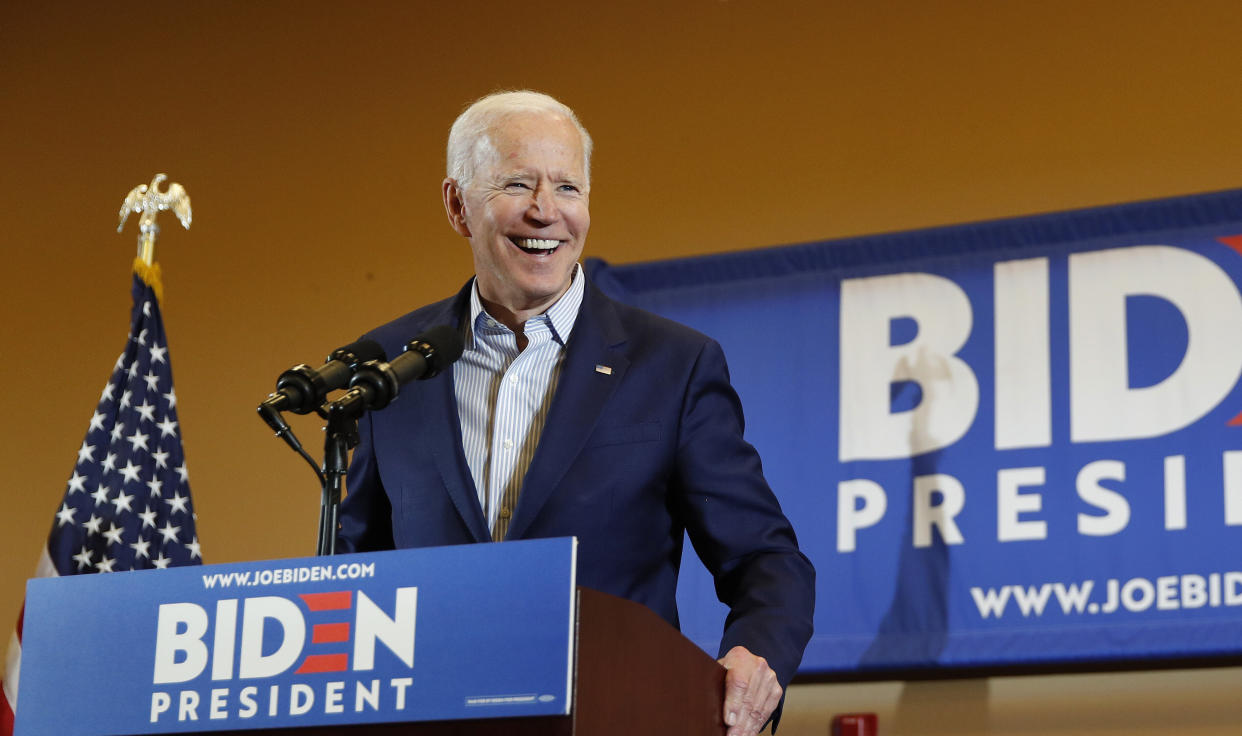Biden's lead over Sanders keeps growing. Here's why.

Now it’s official: Joe Biden is eating Bernie Sanders’s lunch.
When the former vice president launched his third White House bid two weeks ago, on April 25, most experts expected him to get a bounce in the polls. And he did: Seven days later, Biden’s polling average was up nearly 6 percentage points, to 35 percent, and his lead over the next closest Democratic candidate — the senator from Vermont — had grown by nearly 16.
But all candidates’ numbers soar when an announcement is made, right? And everyone promptly drifts back down to earth? After all, that’s certainly what happened to Sanders after he entered the race in February.
Except now. Biden is entering week two of his campaign — and he still appears to be gaining altitude.
The numbers tell the tale. This week, Biden’s polling average has climbed 4 more points, to 39 percent. The three most recent national surveys — the only ones released since the start of May — show him topping 40 percent. Although the initial polls hinted at the source of Biden’s growing support, the latest round makes it clear.
His rise is coming largely at Sanders’s expense.
On April 25, Sanders was holding steady at 23 percent, on average. Then Biden jumped in. One week later, Sanders had slipped to 17 percent. Now, two weeks later, he has plummeted to his lowest polling average of the entire cycle: 15.5 percent.
All told, Biden’s average lead over Sanders has nearly quadrupled since he began his campaign. Individual polls put Biden ahead by as much as 32 percentage points, with broad-based support among key constituencies (black voters, in particular) that comprise the Democratic coalition.
“A lot of Sanders voters seemed to be somewhat on the fence, waiting to see if Biden would get in,” says Tim Malloy, assistant director of the Quinnipiac University Poll. “The second he did, they had a ‘wait a second’ moment — and Sanders dropped dramatically as a result.”
Other candidates have also lost ground to the former Delaware senator; former Texas Rep. Beto O’Rourke has fallen about 2 points, on average, and California Sen. Kamala Harris is down by 1.
But no one is shedding as much support to Biden as Sanders.

Yes, the Iowa caucuses are still 271 days away. And yes, things can (and almost certainly will) change between now and then.
But the trendline is telling.
At first glance, the Bernie-to-Biden exodus seems strange. Sanders’s fans are supposed to be die-hard anti-establishment lefties who couldn’t possibly bear to back anyone less pure than the lifelong democratic socialist from Vermont — let alone a middle-of-the-road, corporate-friendly representative of the Democratic mainstream like Biden.
But dig deeper into the polling, and two patterns emerge — patterns that spell trouble for Sanders going forward.
The first is that before Biden, Sanders was drawing a lot of his support from voters who don’t fit the lefty mold. In late March, for instance, the Quinnipiac Poll found that 15 percent of Sanders’s supporters described themselves as “moderate or conservative,” and 23 percent described themselves as only “somewhat” liberal — more, it’s worth noting, than the 21 percent who described themselves as “very” liberal. At that point, Biden had yet to formally announce, and he led Sanders 29 percent to 19 percent overall.
The bad news for Sanders is that although the new edition of the Quinnipiac Poll — the first released post-Biden — shows him hanging onto nearly all of his very liberal supporters (19 percent), it also shows him hemorrhaging voters who call themselves somewhat liberal (now down to 11 percent) and moderate or conservative (now down to 5 percent).
Where did they go? They went almost entirely to Biden, who over the same period improved his standing by 7 points among moderates/conservatives (to 44 percent) and by 13 points (to 39 percent) among “somewhat” liberals — enough to put him ahead of Sanders 38 to 11 percent overall.
In other words, there’s actually more overlap between the Biden base and the Sanders base than many pundits assume. The fact that so many of these softer Sanders supporters — the ones less interested in ideological purity than, say, perceived electability or blue-collar appeal — were willing to switch sides as soon as “electable” “Middle Class Joe” jumped into the race serves to expose the shakiness of Sanders’s coalition and should come as a distressing sign to the Vermonter, regardless of whether Biden’s bounce fades. (Sanders seems to be aware of this, personally spearheading a strategy to draw an immediate contrast with Biden and telling ABC News, “I don’t think there’s much question about who’s more progressive.”)
Which brings us to second pattern that surfaces in the post-Biden polling: Sanders doesn’t have much room left to grow, especially with Biden as a rival. Analysts often cite Biden’s near-universal name recognition, which stands at 99 percent among Democratic primary voters, to argue that his standing is largely a function of familiarity and might not last.
Yet the same could be said of Sanders, whose name recognition, at 98 percent, is statistically identical to Biden’s.

The problem here is that persuading new voters to come onboard is harder when they’ve pretty much already made up their minds about you — so you had better be starting from a strong position.
Biden is. Sanders isn’t.
Winning Iowa and New Hampshire usually requires support in at least the low- to mid-20s, and as FiveThirtyEight’s Nate Silver has shown, all seven presidential candidates in the last half century with high name-ID who were polling between 15 and 20 percent at this point in the cycle — Jeb Bush, Joe Lieberman, Elizabeth Dole, Jesse Jackson, Gerald Ford, George Wallace and Hubert Humphrey — went on to lose their party’s nomination. Even though Biden can probably afford to lose 10 points and still fend off a late-surging rival, Sanders has to find another 10 points somewhere. With Biden siphoning off Sanders’s more moderate supporters — and with perceptions of Sanders largely baked in — it’s not clear where else those votes can come from.
Not every candidate has the same limitations. Take Massachusetts Sen. Elizabeth Warren — the only major Democratic contender to see her average polling numbers rise, on net, since Biden entered the race. (Starting at 6.5 percent, they climbed as high as 8.8 before settling at 7.7.) With slightly lower name ID (88 percent) she was, unlike Sanders, able make significant gains in the Quinnipiac polling among the groups least inclined to back Biden, including “very” liberal voters (+16 points from late March to late April); voters making more than $100,000 a year (+8); and women (+9). In short, the less your base overlaps with the frontrunner’s, the more room you have to maneuver.
None of which is to say that Biden is a lock to win the Democratic nomination or that Sanders is DOA. It’s possible that Biden isn’t as formidable a candidate as he seems right now; he could commit a campaign-ending gaffe at any moment or fail to impress on the trail. He’s enjoying as much cable-news coverage as every other candidate combined — a boon that will soon subside. And the electability argument hasn’t worked out so well for Democrats in the past.
But while Biden’s early bounce isn’t proof of his everlasting supremacy, it is evidence of Sanders relative weakness. Unless the Vermont senator can find a way to expand his base beyond hard-core fans and softer supporters who are willing to immediately jump ship for the other well-known white male septuagenarian in the race, he’s unlikely to be facing off against the well-known-white-male-septuagenarian-in-chief next November.
_____
Read more from Yahoo News:




